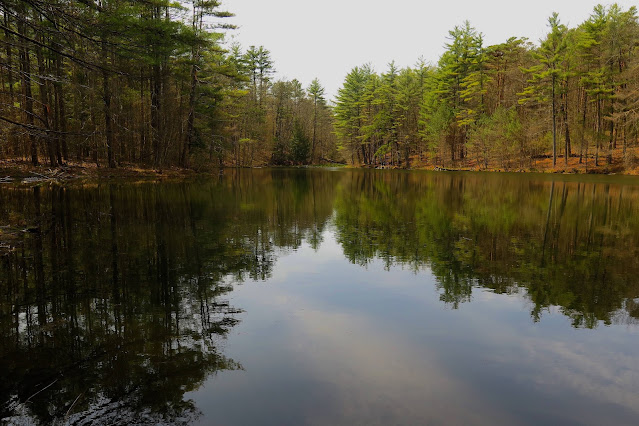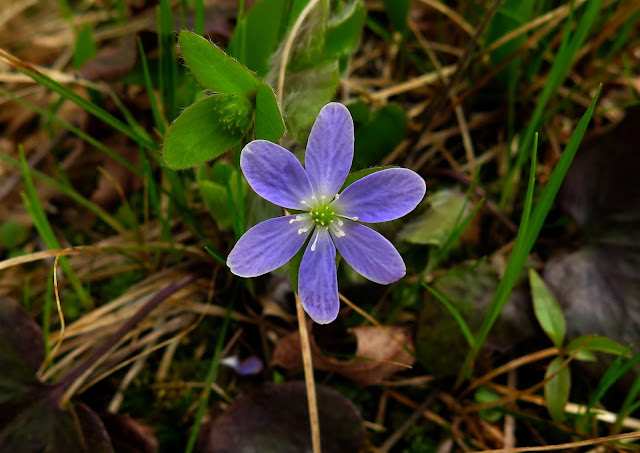While yellow flowers took center stage in the Skidmore Woods this week (see last post), the whites were what were blooming at Woods Hollow Nature Preserve when I stopped in there briefly yesterday. The bloom-laden boughs of a Shadblow tree (Amelanchier sp.), its flower clusters floating like puffs of white clouds against the dark trees, set the theme as I made my way to the pine-edged pond that lies at the center of this 130-acred preserve just north of Ballston Spa.
For more than thirty years I've been wandering the woods and waterways of Saratoga County, New York, and regions nearby, looking closely, listening carefully, and recording what I experience. We are blessed in this region with an amazing amount of wilderness right at hand. With this blog I share my year-round adventures here, seeking out what wonders await in my own Madagascar close to home.
Friday, May 6, 2022
All The Whites At Woods Hollow
OK, the first flowering shrub that I passed as I made my way around the pond held buds that were definitely pink, not white. But these were the buds of Highbush Blueberry flowers (Vaccinium corymbosum), which will indeed be white when the bell-shaped flowers emerge in a very few days. A bit pink-tinged, but mostly white.
When I turned onto a wooded trail at the far north-eastern end of the pond, I was met with the sight of uncountable numbers of tiny white violets carpeting almost an entire hillside.
I'm not sure which Viola species this is, since we have several species of small white basal-leaved violets that I have difficulty distinguishing. But my best guess is Northern White Violet (V. pallens), based on the rounded shape of its leaves, sweet fragrance, and early bloom time. Another option might be the Sweet White Violet (V. blanda), equally white and small and fragrant. But as Juliet once explained about roses to Romeo, a violet "by any other name would smell as sweet." And be just as beautiful.
Just beyond these masses of violets lies a low swampy area paved with more white flowers. Among them were these delicate beauties called Goldthread (Coptis trifolia), holding their flowers on slender stems above their ground-hugging three-parted leaves. The "gold" implied by this pretty plant's vernacular name does not refer to those yellow lollipop-shaped "petals" (the white parts are actually sepals), but rather to its bright-yellow thread-like underground roots.
The most abundant denizen of this swampy spot is the low-lying species called Dwarf Ginseng (Panax trifolius), which was just beginning to open its umbels of tiny white star-shaped flowers. This plant is a true "spring ephemeral," since as soon as its flowers drop the seeds that replace its blooms, all evidence of this plant's existence will disappear until the following spring. I'm happy I was able to catch it in bloom, even if only partially so.
I eventually made my way to the southern end of the pond, where a sphagnum-lined boggy spot on the shore supports a population of Leatherleaf shrubs (Chamaedaphne calyculata). I feel lucky I didn't miss the long arching stalks dangling rows of bell-shaped flowers while they still appeared pristine. This is one of our earliest-to-bloom flowering shrubs, and I feared that I might have missed seeing them this year. Our cold spring must have delayed or sustained their bloom. Yay!
No flowers on these plants of Checkered Rattlesnake Plantain (Goodyera tesselata) as yet, but when they shoot up from the center of their pale-patterned basal leaves in a month or so, they will indeed be white: tiny white orchids climbing their leafless stalks. As the litter of pine needles surrounding these plants suggests, this native orchid loves the acidic soil of a pine-populated woods.
All right, what's this blue flower (a Round-leaved Hepatica) doing in my post about white-flowered plants? Well, I couldn't ignore it, because I was so surprised to see it. Most of our hepaticas, both the Round-lobed (Hepatica americana) and the Sharp-lobed (H. acutiloba) have finished their blooming for the year and have already gone to seed. This plant, too, is already producing the spiky seedpods set within three-parted bracts you can see right behind the blue flower. How happy I am that I got to see just one more of its beautiful flowers, especially one that wasn't plain white (which many of them are), but one of this radiant blue color instead.










No white hepatica, eh? How about spring beauty -- I usually consider spring beauty a pink flower although it's mostly white and certainly fades to white as the flowers age.
ReplyDelete